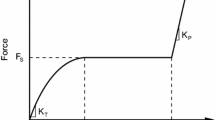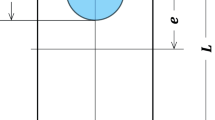Abstract
Pinned (bolted) joints are an extremely important, but difficult to analyze, structural or mechanical element. They are a class of inverse problems in which the stresses at the pin/hole interface are typically unknown. Moreover, stresses vary non-linearly with applied load. Failures of mechanical or structural systems frequently initiate at connections. Although almost always present, many stress analyses of such mechanical connections ignore friction for simplicity. The stresses are evaluated here in an aluminum connector using a series solution of an Airy stress function, the coefficients being evaluated from known boundary tractions (near, but not including the contact region on the hole) and photoelastically measured data obtained from a bonded birefringent coating. Both friction and pin/hole clearance are accounted for, and individual stresses are evaluated full-field, including on the contact boundary of the hole.












Similar content being viewed by others
References
Frocht MM, Hill HN (1940) Stress concentration factors around a central circular hole in a plate loaded through a pin in the hole. Trans ASME J Appl Mech 7:5–9
Meek RMG (1967) Effects of pin bending on the stress distribution in plates loaded through pin joints, National Engineering Laboratory Report No. 311, East Kilbride, UK
Waszczak JP, Cruse TA (1971) Failure mode and strength prediction of anisotropic bolt bearing specimens. J Compos Mater 5:421–425
Wong CM, Matthews FC (1981) A finite element analysis of single- and two-hole bolted joints in fiber reinforced plastics. J Compos Mater 15:481–491
Wilkinson TL, Rowlands RE (1981) Analysis of mechanical joints. Exp Mech 21(11):408–414
Rowlands RE, Rahman MU, Wilkinson TL, Chiang YI (1982) Single- and multiple-bolted joints in orthotropic materials. Composites 13(3):273–279
Hyer MW, Liu DH (1983) Photoelastic determination of stresses in multiple-pin connectors. Exp Mech 23(3):249–256
Rahman MU, Rowlands RE, Cook RD (1984) An iterative procedure for finite-element stress analysis of frictional contact problems. Comput Struct 18(6):947–954
Hyer MW, Klang EC (1985) Contact stresses in pin-loaded orthotropic plates. Int J Solids Struct 21(9):957–975
Mahajerin E, Sikarskie DL (1986) Boundary element study of a loaded hole in an orthotropic plate. Compos Mater 20:375–389
Eriksson LI (1986) Contact stresses in bolted joints of composite laminates. Compos Struct 6:57–75
Tsai MY, Han B, Morton J, Post D (1989) Contact stresses in pin-loaded plates: an experimental study. Proceedings of the 1989 SEM Spring Conference on Experimental Mechanics, Cambridge, MA, pp 557–564
Stanley P, Davies MF (1991) A photoelastic study of the stresses in pin-loaded lugs,” österreichishe ingenier-und architekten-zeitschrift (ÖIAZ) 6:275–284
Shih (Stone) JS (1992) Experimental-Numerical analysis of bolted joints in finite composites with and without inserts, PhD Thesis, University of Wisconsin-Madison
Stanley P, Dulieu-Smith JM (1992) A thermoelastic study of the stresses in pin-loaded lugs. Proceedings of the 6th National Symposium for Experimental Mechanics, Craiova, pp 160–169
Dulieu-Smith JM, Fulton MC (1996) Thermoelastic stress analysis of the interfacial conditions in pin-loaded lugs. Proceedings of VIII International Congress on Experimental Mechanics, Nashville, pp 39–46
Mallory-Patton M (1996) Three-dimensional mechanics and failure of single bolt wood connections, PhD Thesis, Colorado State University, Fort Collins, CO
Bauman BJ (1998) A numerical and experimental investigation of mechanical connections, PhD Thesis, University of Wisconsin-Madison
Lanza di Scalea F, Hong SS, Cloud GL (1998) Whole-field strain measurement in a pin-loaded plate by electronic speckle pattern interferometry and the finite-element method. Exp Mech 38(1):55–60
Ju SH, Rowlands RE (2001) A three-dimensional frictional stress analysis of double-shear bolted wood joints. Wood Fiber Sci 33(4):550–563
World Trade Center Building Performance Study: Data Collection, Preliminary Observations and Recommendations, FEMA Report # 403, FEMA Region II, New York, New York, September 2002
Foust BE, Rowlands RE (2003) Inverse stress analysis of pinned connections using strain gages and Airy stress function. Inverse Problems in Engineering Mechanics, (ISIP 2003), Nagano, Japan, M. Tanaka, editor, pp 323–332
Foust BE (2003) Individual stress determination in inverse problems by combining experimental methods and Airy stress functions. Thesis, University of Wisconsin-Madison, Madison, WI
Lesniak JR (2000) A stress integrating thermoelastic and photoelastic stress analysis development of an automated grey-field polariscope. NASA Report # NASI-97036 by Stress Photonics
Shukla A, Dally JW (2010) Experimental Solid Mechanics, College House Enterprises, LLC, Knoxville, Tennessee
Huang YM, Lin CH, Suhling JC, Rowlands RE (1991) Determining the three individual stress components from measured isochromatic fringes. Exp Mech 31(4):310–317
Hawong JS, Lin CH, Lin T, Rhee J, Rowlands RE (1995) A hybrid method to determine individual stresses in orthotropic composites using only measured isochromatic data. J Compos Mater 29(18):2366–2387
Baek TH, Rowlands RE (2001) Hybrid stress analysis of perforated composites using strain gages. Exp Mech 41(2):195–203
Rhee J, Rowlands RE (2002) Moiré-numerical hybrid analysis of cracks in orthotropic media. Exp Mech 42(3):311–319
Huang YM, Rowlands RE (1991) Quantitative stress analysis based on the measured trace of the stress tensor. J Strain Anal 26(1):55–63
Lin ST, Rowlands RE (1995) Thermoelastic stress analysis of orthotropic composites. Exp Mech 35(3):257–265
Lin ST, Feng Z, Rowlands RE (1997) Thermoelastic determination of stress intensity factors in orthotropic composites using the J-integral. Eng Fract Mech 56(4):579–592
Ju SH, Rowlands RE (2003) Mixed-mode thermoelastic fracture analysis of orthotropic composites. Int J Fract 120:601–621
He KY, Rowlands RE (2004) Determining stress intensity factors in orthotropic composites from far-field measured temperatures. Exp Mech 44(6):555–561
Lin S-J (2007) Two- and three-dimensional photomechanical-numerical stress analysis, Thesis, University of Wisconsin, Madison, WI
Lin S-J, Matthys DR, Rowlands RE (2009) Separating stresses thermoelastically in a central circularly perforated plate using an Airy stress function. Strain 45(6):516–526
Lin S-J, Quinn S, Matthys DR, New AM, Kincaid IM, Boyce BR, Khaja AA, Rowlands RE. Thermoelastic dtermination of individual stresses in vicinity of a near-edge hole beneath a concentrated load. Experimental Mechanics, in press
Foust BE, Rowlands RE. Thermoelastic determination of individual stresses in a diametrically-loaded disk. Strain 47:146–153
Sanford RJ (1980) Application of the least-squares method to photoelastic analysis. Exp Mech 20:92–197
Soutas-Little RW (1973) Elasticity. Dover, Mineola
Daniel IM, Ishai O (2006) Engineering mechanics of composite materials. Oxford University Press, New York
Juvinall RC, Marshek KM (2005) Fundamentals of machine component design, 4th edn. Wiley, New York
Collins JA (2003) Mechanical design of machine elements and machines. Wiley & Sons, Inc., New York
Acknowledgements
The authors wish to thank the US Air Force for providing funds (Grant #FOSR FA9550-05-1-0289) with which to purchase the GFP equipment, and John Dreger and Wa’el Abdel Samad of the University of Wisconsin-Madison for their assistance.
Author information
Authors and Affiliations
Corresponding author
Appendices
Appendix I
Since any coating adhered to a structure carries part of the load, there can be a concern whether the coating provides any significant reinforcing. Strains in a bonded birefringent coating (assuming the in-plane strains in the coating equal those in the structure) are related to those which would occur in the uncoated structure as follows [25]:
where the correction factor, F cr , is given by:
with t, E and ν being the thickness, modulus and Poisson’s Ratio, respectively. Superscript u is associated with strains which would exist in the uncoated member, superscript c is associated with those determined photoelastically in the bonded coating, and subscripts s and c refer to the structure (aluminum) and coating, respectively. Based on the t c /t s = (0.33 mm/6.48 mm) = 0.051, E c = 5.86 GPa, E s = 69 GPa, νs = 0.33 and ν c = 0.4, F cr = 1.004. One could at least double the thickness of this cast epoxy coating (so F cr = 1.008) without reinforcing concerns, although the transition zone at edges would then increase to 2.64 mm. Using a 2.03 mm (0.08 inches) thick commercial coating (e.g., PS-1 by Vishay Measurement Group, K = 0.14, E c = 2.48 GPa) would dramatically increase the isochromatic sensitivity, the correction factor, F cr would still be only 1.01, but the edge transition distance would now exceed 8 mm (0.3 inches), which slightly exceeds 60% of the radius of the hole.
Appendix II
The vertical loading of the present pin connection results in symmetry about the x-axis and this enables the sine terms to be omitted from the stress function of equation (4). However, suppose a torque were applied to the pin such as to superimpose an additional shear (frictional) stress of constant direction around the edge of the hole of Fig. 1. The plate would then have to be restrained in some manner (perhaps by an external in-plane torque or additional in-plane forces) to resist this torque. The situation in the plate would then not be symmetrical about either the x- or y-axis and equation (4) would have to retain both sine and cosine terms. The expressions for the stresses would correspondingly become more complicated.
Rights and permissions
About this article
Cite this article
Foust, B.E., Lesniak, J.R. & Rowlands, R.E. Determining Individual Stresses Throughout a Pinned Aluminum Joint by Reflective Photoelasticity. Exp Mech 51, 1441–1452 (2011). https://doi.org/10.1007/s11340-011-9477-0
Received:
Accepted:
Published:
Issue Date:
DOI: https://doi.org/10.1007/s11340-011-9477-0




